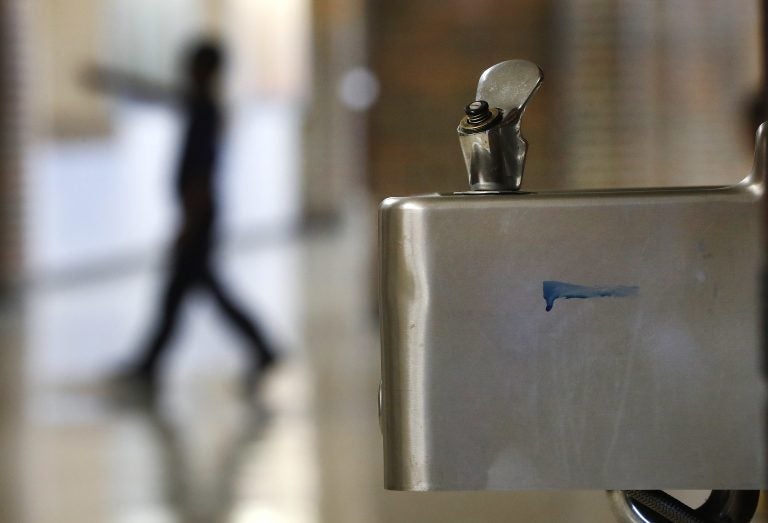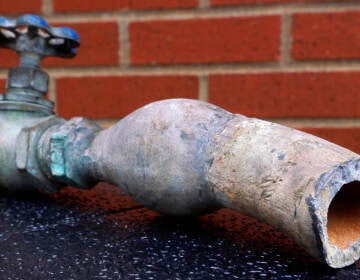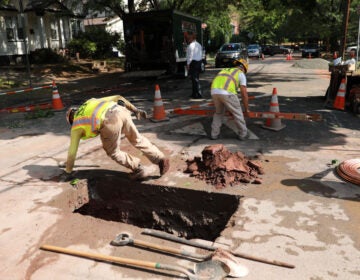Criticizing inaction on lead in N.J. schools’ drinking water supplies
The Department of Education was invited to be part of the roundtable event but declined.

A student walks in the hallway past a water fountain at Noble School in Detroit, Tuesday, Sept. 4, 2018. (Paul Sancya/AP Photo)
Despite lead in drinking water supplies having been detected in hundreds of New Jersey’s public school buildings, advocates say there appears to be no rush to figure out how to divvy up $100 million in new money among districts eager to fix the problem.
The advocates are pushing the state to more aggressively come up with plans for how to spend dollars from a bond issue voters approved last November that was geared to replacing lead service lines in schools throughout the state — or fix the problem through less costly alternatives.
The state Department of Education came under repeated criticism from advocates yesterday at an NJ Spotlight Roundtable in Hamilton on Achieving Lead-Free School Water in New Jersey. They questioned why all school districts were not required to do lead testing at their facilities, to report testing results to the department, and to communicate that information to the public.
“It’s incumbent on the Department of Education to tighten up its rules on testing,’’ said Sen. Linda Greenstein (D-Mercer), a longtime advocate for dealing with lead in drinking water.
“When it comes to data, we have a partial story,’’ said Chris Sturm, managing director of policy and water for New Jersey Future, a nonprofit organization that has compiled the most comprehensive analysis of lead testing results in schools. “We know this is a pervasive problem.’’
The children at greatest risk
Her organization compiled preliminary results of lead testing by school districts in 2016 and found that at least 300 districts had at least one outlet within their systems that had a problem with lead. There are no safe levels of lead in drinking water, a problem posing a threat to young children, causing learning disorders and behavioral problems.
“We need to take a careful look at kids with the greatest risk who live in communities with the highest levels of lead in their blood with the fewest resources to address the problem,’’ Sturm urged.
The Department of Education was invited to be part of the roundtable event but declined. In a statement, the department said all New Jersey school districts and charter schools have submitted a Statement of Assurance to the DOE, signifying their conformity with the compliance requirements.
Every district must make all test results available to the public at the school facility and at the district’s website, according to the department.
Lead poisoning remains a particularly difficult issue for policymakers in New Jersey. In Gov. Phil Murphy’s recent State of the State message, he noted more than 1.5 million residents across the state are currently serviced by water with elevated lead levels, but he offered no new initiatives to deal with the problem.
The Chicago solution
In Chicago, lead in water emerged as a huge issue in 2016, according to Robert Christlieb, director of operations for facilities at that city’s public school system. Thirty-seven percent of their buildings found lead levels above the federal government’s action level of 15 parts per billion (ppb), Christlieb said.
Most of the problems with the lead levels were solved with small fixes, he said. After long discussions, the district moved to a system of automatically flushing the schools’ fountains and other outlets that proved more cost-effective than having school staff do the flushing as part of their day.
Others argued that more long-term fixes are needed, including replacing lead service lines and other fixtures where lead may leach from plumbing into the water supply.
“We think long-term fixes ought to be the priority,’’ said Dan Kennedy, director of environmental and utility operations for the Utility and Transportation Contractors Association.
That option, however, is expensive. Valerie Wilson, business administrator for Newark schools where lead levels emerged as a big problem three years ago, noted her district projected the cost of replacing all pipes in the school system at $37 million.
“Let’s make sure we do this responsibly,’’ Wilson said.
WHYY is your source for fact-based, in-depth journalism and information. As a nonprofit organization, we rely on financial support from readers like you. Please give today.



